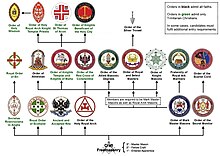Structure and organisation
The Order meets in local Councils, each having an elected presiding officer named the Thrice Illustrious Master, who appoints a number of assisting officers. Councils are grouped into districts, each governed by a District Grand Master, who likewise appoints district officers. The Grand Council in London governs around 240 Councils, mostly in England and Wales, but with some overseas. The Grand Council in London controls overseas districts in South Africa, the Caribbean, and the Channel Islands, and also controls a few isolated overseas councils in the Isle of Man and across several nations of western Europe and the Far East. [3]
The Grand Council exercises control of six degrees. The first four are worked by local councils of the Order, and most members will progress through all four degrees. This series of degrees is based on the Masonic legend of King Solomon's Temple and throws light on the links between the degrees of Master Mason, Mark Master Mason, and the Holy Royal Arch. [4] [5] They are the degrees of:
- Select Master
- Royal Master
- Most Excellent Master
- Super-Excellent Master
The two additional degrees are granted more sparingly to those who have a history of long or distinguished service to the Order. They are worked only in certain Councils, licensed for that purpose by the Grand Master. They are the degrees of:
- Thrice Illustrious Master (commonly known as the Order of the Silver Trowel) [4]
- Excellent Master (also known as passing the veils) [6]
The degree of Thrice Illustrious Master (Silver Trowel) should not be confused with the title of the presiding officer of a Council, which is "Illustrious Master", but otherwise unconnected.
This page is based on this
Wikipedia article Text is available under the
CC BY-SA 4.0 license; additional terms may apply.
Images, videos and audio are available under their respective licenses.

